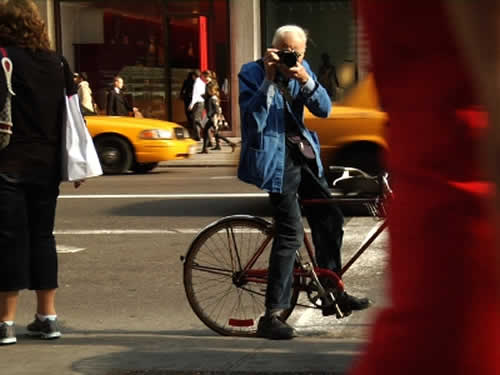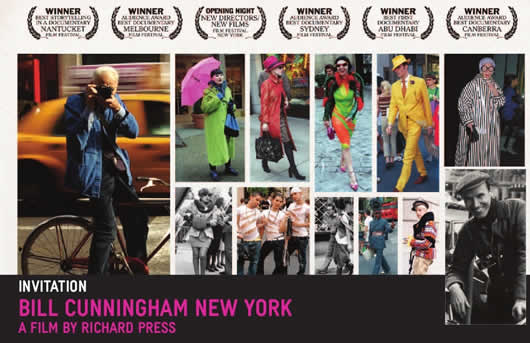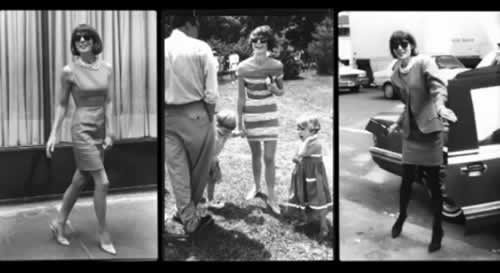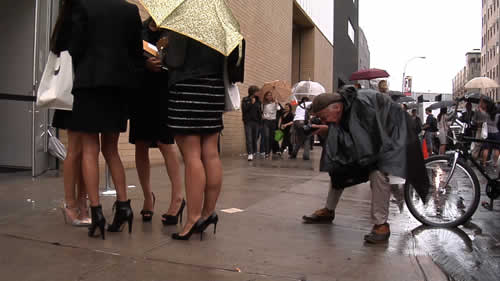 On Wednesday, March 23, 2011, the Costume Council of the Los Angeles County Museum of Art (LACMA) and Gilt Groupe previewed Zeitgeist Films’ award-winning documentary, “Bill Cunningham New York” at a special screening and reception in Los Angeles. The film opened on March 15 to record box office numbers at Landmark’s Nuart Theatre and moved this week to the Laemmle Sunset 5. March 23rd’s evening event was sponsored by Gilt Groupe, an innovative online luxury-shopping site (www.gilt.com/lacma).
On Wednesday, March 23, 2011, the Costume Council of the Los Angeles County Museum of Art (LACMA) and Gilt Groupe previewed Zeitgeist Films’ award-winning documentary, “Bill Cunningham New York” at a special screening and reception in Los Angeles. The film opened on March 15 to record box office numbers at Landmark’s Nuart Theatre and moved this week to the Laemmle Sunset 5. March 23rd’s evening event was sponsored by Gilt Groupe, an innovative online luxury-shopping site (www.gilt.com/lacma).
Event attendees included Costume Council members, invited guests, and fashion and film industry luminaries – many bedecked in outfits worthy of inclusion in photog Bill Cunningham’s weekly New York Times fashion column, ‘Man on the Street’.
After the sneak preview in LACMA’s Bing Theatre, Ian Birnie (Consulting Curator of LACMA’s Film Department) interviewed director Richard Press and producer Philip Gefter about filming the fabled iconoclastic photographer, Bill Cunningham. Director Richard Press and husband/producer Philip Gefter spent eight years convincing Bill to become the subject of their film, which took another two years to complete.
Cunningham has turned down hundreds of offers to work on books, exhibitions or lectures. The modest Cunningham needs his time for his sworn métier. “Money is the cheapest thing,” he says. “Liberty is the most expensive.”
Press was confined to shooting “discreetly, quietly, and invisibly”. Mimicking Cunningham’s unobtrusive style, Press used a hand held consumer camera, following Bill’s spontaneous lead to whatever interested him around town.
Gefter has recounted his experiences following Cunningham from event to event on a jury-rigged adult-size tricycle. Cunningham, who’s in shape from his ceaseless bike rides, teased the two-man team he ran ragged. In a recent article Gefter described their working relationship, “We were given a cubicle next to Bill’s at the Times during the filming of the movie. We would sit there for weeks at a time…anticipating his moods before broaching a cinematic need to follow him on an evening’s round of parties, or to interview him in his apartment, or to ask him for archival pictures. It was fine for us to film him as long as we were spontaneous about it and it did not interrupt the organic flow of his routine. If we asked him when he was going out to shoot on the street, he would…slip out when we weren’t looking. But if we simply appeared on the street with our cameras, he would reward us with his cooperation.” (The Daily Beast)
Gefter told a story about Bill’s days working at Chez Ninon, a couture salon owned by the socially well-connected Nona Park and Sophie Shonnard, which made legitimate copies of the European designers such as Chanel, Givenchy, and Dior. (Best-dressed Babe Paley was one of their clientele that grew out of their original Bonwit Teller custom salon.) Jackie Kennedy, a regular client, sent her Chez Ninon red Dior suit back to New York for Bill to dye black. She wore it at the President’s funeral. (Jackie was wearing her Chez Ninon copy of a Chanel pink boucle wool suit when President Kennedy was shot. That suit is in the National Archives.)
Stormy weather didn’t deter the fashionati from the event, although the reception, originally planned to take place on LACMA’s Los Angeles Times Central Court, was moved indoors to the Ahmanson building where attendees sporting bright blue “We all get dressed for Bill” buttons (Anna Wintour’s famous quote) enjoyed New York pretzels, warm chestnuts and champagne.
Some of the attendees at the New York-themed party included Decades owner Cameron Silver, fashion designer Jeremy Scott, rock & roll stylist and artist Michael Schmidt, Robert Mappelthorpe muse Constance, journalist Rose Apodaca, retro Americana historian Charles Phoenix and Annie Flanders, founding editor of Details magazine and long-time friend of Cunningham. Flanders sported a Mallard hand muff made by Bill.
Elizabeth Matthews, a Director of the Board and Chair of PR and Communications for the Costume Council, describes the genesis of the event, “After a year of planning and collaboration with Zeitgeist Films, director Richard Press, producer Philip Gefter and Gilt Groupe, the Costume Council was thrilled to produce an event to celebrate “Bill Cunningham New York” in Los Angeles. The incredible response from the media, and the fashion and film industries, is a testament to the film’s portrayal of Bill’s tireless energy and spirit – culminating in a jubilant full house at the reception!”
 The Costume Council is the largest of LACMA’s ten Art Councils. Established in 1954, the Costume Council provides resources to expand audience awareness of fashion, design, costume and textiles, while increasing the breadth and depth of LACMA’s world-class Costume and Textiles collection.
The Costume Council is the largest of LACMA’s ten Art Councils. Established in 1954, the Costume Council provides resources to expand audience awareness of fashion, design, costume and textiles, while increasing the breadth and depth of LACMA’s world-class Costume and Textiles collection.
The Costume Council was instrumental in the recent acquisition of the historic, rare European costume collection put together by London collector Martin Kamer and Galerie Ruf in Beckenried, Switzerland – and was celebrated in the extraordinary “Fashioning Fashion: European Dress in Detail, 1700–1915”, one of three inaugural exhibitions in LACMA’s new Resnick Pavilion. The popular exhibition displayed merely a third of the collection, which has elevated LACMA’s Costume holdings to world-class status.
CEO Michael Govan, Sharon Takeda (Senior Curator and Department Head of Costume and Textiles) and Costume Council member, Ellen Michelson, viewed the collection in Europe. A significant gift from Michelson, and her husband Michael, for a third of the collection, brought the collection to Los Angeles to pursue additional funds. Additional gifts from the Costume Council and other patrons, including a major gift from patron and collector, Suzanne Saperstein, (for more than half of the acquisition price) ensured that the entire collection would remain at LACMA. This single acquisition has made LACMA an International destination for researchers in the field of European Fashion.
The Costume Council hosts fashion-focused, behind-the-scenes events for its exclusive membership from presentations by well-known designers, curators and authors, to cocktail receptions, film premieres, fashion shows, in-store previews, and book-signings. The preview of Bill Cunningham New York was one of many film premieres the Council has hosted in recent years from “Valentino” to “Ultrasuede: In Search of Halston.” Visit www.costumecouncil.org to learn about not-to-be-missed 2011 programs with Chanel, Judith Leiber, Vivienne Westwood and Cirque du Soleil.
The evening’s sponsor, Gilt Groupe, provides invitation-only access to highly coveted products and experiences at insider prices. Each day, Gilt offers its members a curated selection of merchandise, including apparel, accessories and lifestyle items across the women’s, men’s and children’s categories, home decor and entertaining essentials, along with luxury travel packages and fantastic offers on local services and experiences. A dedicated invitation for the Costume Council event – www.gilt.com/lacma – offers a direct invite to Gilt’s members-only website, and as a special perk, can also be accessed by our Cinema Without Borders readers.
FILM REVIEW:
Cunningham, who despite speculation that he came from gentry, came from a solid “working class” background, and moved to New York to become a milliner.
Some of his fabulous hats are modeled in the film by Editta Sherman, his long-term neighbor at the fabled Carnegie Hall Studios. Cunningham and Sherman were among the last six holdout tenants, as the building was slowly transformed from legendary Studios to offices and teaching facilities. An attempt to rescue the fate of the Studios with help from Mayor Blumberg came to naught.
Sherman, a 98-year-old photographer, known as the Duchess Of Carnegie Hall, raised five children in her rent controlled studio with 25-foot ceilings and a view of Central Park. Sherman’s studio, which feels like Bill’s annex, is filled with glamour shots of the lifetime of artists and celebrities who flocked to her Studio for portraits since 1949. She was the model for Cunningham’s book “Facades.”
The Carnegie Studios was home to Mark Twain, Paul Swan, Leonard Bernstein, Bobby Short, and Marlon Brando to name just a few. Agnes de Mille, Isadora Duncan and Jerome Robbins choreographed there. Norman Mailer wrote there. Marilyn Monroe, Grace Kelly, Robert Redford, Lucille Ball and James Dean studied in the historic studios.
Cunningham lived most of his life in a tiny studio, filled with filing cabinets, with a bathroom down the hall. “Who the hell wants a kitchen or a bathroom? ” snaps Bill, as he shows off his closet (hangers on a filing cabinet) and his twin mattress on a board. The film follows him as he tours apartments where the developers propose to relocate him. Cunningham finally settles on a spacious apartment with a view of Central Park.
A friend gave Cunningham his first camera, and told him to use it as a pencil. One of his first shoots was the 1969 Be-in at Central Park’s Sheep Meadow. His famous black and white photos (he couldn’t afford color stock) of the Love Generation’s anarchic costume party put him on the map. A photo of Garbo (he snapped her Nutria coat, unaware of who she was) landed him at The New York Times.
Cunningham, who considers himself a social/ fashion anthropologist, spent decades following the message of fashion in the streets, first for the original “Details Magazine” (which was almost a one man photo-gallery), next Women’s Wear Daily, then The New York Times. Although not mentioned in the film (but perhaps in the DVD extras), Cunningham created the masks for Truman Capote’s legendary Black and White Ball, documented Studio 54 and covered Yves St. Laurent since his very first show.
No paparrazi – he’s uninterested in celebrities, preferring to chronicle human nature through the clothes people wear to express themselves.
It’s great fun watching opinionated Bill advise his art-director as he tracks his original free associations, found patterns and thematic details to compose one of his pages.
Talking heads Tom Wolfe, Brooke Astor, Annette De la Renta, Iris Apfel, and David Rockefeller laud Cunningham as a true American original. Anna Wintour, Editor in Chief at Vogue magazine, famously
quotes, “We all get dressed for Bill. He has been documenting me since I was a kid, one snap, two snaps, or he ignores you which is death,” she said of his decades-long chronicling of her fashion choices.
Dandy Patrick McDonald, who was ‘made’ around town when Bill featured a full article of his many custom-hatted outfits, describes the inspiring artistry of Bill’s work.
 Social lioness Brooke Astor, with whom he had a long friendship, was one of his muses and fashion icons. His second column “Evening Hours” was often full of pictures of his gracious friend Astor, who he described as a democratic person. He was the only press person invited to Mrs. Astor’s 100th Birthday Party.
Social lioness Brooke Astor, with whom he had a long friendship, was one of his muses and fashion icons. His second column “Evening Hours” was often full of pictures of his gracious friend Astor, who he described as a democratic person. He was the only press person invited to Mrs. Astor’s 100th Birthday Party.
Female Dandy Anna Piaggi, known for her creative double page spreads in the Italian Vogue, is another of Cunningham’s perennial muses. Piaggi, whose clothing collection contains 2865 dresses and 265 pairs of shoes, has reputedly never worn the same outfit twice. Her 2006 exhibit “Fashion-ology” at the Victoria and Albert Museum in London celebrated the style arbiter, dubbed by Manolo Blahnik, The world’s last great authority on frocks’.
Determined to report on the full spectrum of Fashion, Cunningham covers Paris Runway shows (his annual education) and how it’s being worn. He documents evening wear in his column “Evening Hours” and street wear in his lively “On The Street” column articles.
Dressed in his iconic blue French Street Sweepers smock (he picks them up when he’s in Paris covering the Runway shows) 82-year-old Cunningham still bikes around New York, as he has for over four decades tracking the stories about fashion that only the street can teach him.
Cunningham sorts through stacks of invitations, warning the organizers of benefits and fundraisers, “Don’t send me the list of attendees. I’m not interested,” selecting foundations who have a mission that interest him. He often covers three to four events a night, always on his ubiquitous bike. His upbeat lack of pretense has endeared him to all strata of society. He calls friends and strangers “Kid” or, in fonder moments, “Child”.
“A publicist offers him a plate of food at one of the high powered evenings he’s chronicling for “Evening Hours”. He refuses, explaining he doesn’t want to be wined or dined. “If you don’t take money, they can’t tell you what to do. That’s the key to the whole thing.”
“You’ve got to stay on the street and let the street speak to you,” he explains as he sifts patterns from the passing parade. “The best fashion show is definitely on the street. It always has been. It always will be. There’s no shortcut. I go to the street. The street tells me. Fashion is the armor to survive the reality everyday life. I don’t think you can do away with it (fashion). It would be like doing away with civilization.”
One of his editors at the New York Times explained, “Bill has never, never sold out. His fingerprints are all over everything he does.” Bill moonlighted for free on the landmark “Details” which devoted hundreds of pages a month to his groundbreaking survey of the social history of fashion.
He caused ripples running current runway fashions, next to his archival photos of the same (earlier) design by another designer. He ran an Armani ‘Original’ next to the Diaghilev costume that inspired it, enraging Armani’s company. “When Bill ran a photo of something that  Isaac Mizrahi had copied, Isaac couldn’t have been lovelier. He made sure we had front row seats after that,” explains Annie Flanders, Publisher of Details.
Isaac Mizrahi had copied, Isaac couldn’t have been lovelier. He made sure we had front row seats after that,” explains Annie Flanders, Publisher of Details.
Flanders describes, ” Bill always kept telling me not to fall into the traps of the rich. He would never take any money from us, ever. After the first issue, we gave him a check and he brought it back, ripped up. He told me he wouldn’t do it if he had to take money. All the founders worked for a percentage of the magazine. I kept a record of every single thing he did. And every time we got a new publisher or owner, I said, “This amount will always be honored.”
When Advance bought Details, Cunningham repeatedly refused the buy-out check. “It was quite a lot by then. And S.I. (Newhouse) would always call me, begging me to get Bill to take the money. But every time I spoke to him, he wouldn’t. It’s still on the books as far as I know,” continued Flanders.
At a ceremony in Paris, investing Cunningham as an Officer of The Legion Of Honor, the ever opinionated and didactic Cunningham tearily states, “He who seeks beauty is destined to find it.” It’s a summing up of a life devoted to the message of life in the street.
As Howard Koda, Curator of the Costume Institute at the Metropolitan Museum of Art, says, “That doesn’t mean he is unaware of cultural vision and hierarchy. He just treats it all the same.”
Press has learned from Cunningham –h;s portrait, a lively assemblage of people and places, calls to mind Bill’s own collaged pages.
A personal interview with self-effacing Cunningham is painful and as revealing as possible given Cunningham’s self-protective skills. Press’ camera hovers a few feet away, as a nervous Cunningham deflects telling questions about romance, gender orientation and “friends”. A question about his Sunday church mornings opens the floodgates, and Bill tears up. It’s a raw, mysterious moment, captured with respect.
www.zeitgeistfilms.com/billcunninghamnewyork

